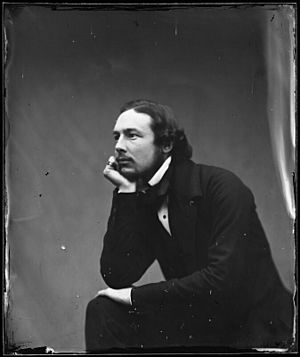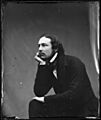George Price Boyce facts for kids
George Price Boyce (born September 24, 1826 – died February 9, 1897) was a British artist. He was known for his beautiful watercolour paintings of landscapes and old buildings. His style was part of the Pre-Raphaelite art movement. He was also a good friend and supporter of another famous artist, Dante Gabriel Rossetti.
Contents
Becoming an Artist: George Boyce's Early Life
George Price Boyce was born in London. His father, George Boyce, was a wine merchant who later became a pawnbroker. George had a sister named Joanna Mary Boyce, who was also a painter.
He went to school in Chipping Ongar, Essex, and later studied in Paris. In 1843, he started training to be an architect. He worked for an architect named Little for four years. After that, he joined another architecture firm.
However, George wasn't happy as an architect. In 1849, he met the artist David Cox. This meeting inspired him to leave architecture and become a watercolour painter instead.
How Did Other Artists Influence Boyce's Style?
George's early paintings showed the influence of David Cox, whom he met again in 1851. But he soon developed his own unique and detailed style. This was thanks to the Pre-Raphaelite painters. He met Thomas Seddon and Rossetti around 1849. Later, in 1853, he met William Holman Hunt and John Everett Millais.
In 1853, he painted in Dinan, France, with Seddon. The next year, in 1854, he traveled to Venice. There, he sketched many scenes suggested by the art critic John Ruskin. Ruskin even wrote to him during his four months in the city.
Exploring England: Boyce's Landscape Paintings
In the late 1850s, much of George's work focused on English landscapes. He often included views of old, traditional buildings in his paintings. He especially loved painting villages along the Thames Valley, like Pangbourne, Mapledurham, Whitchurch, and Streatley. He also painted scenes in Sussex and Surrey.
In the 1870s, he created many paintings of Ludlow. He also started to paint more remote and wilder landscapes across Britain.
Travels and Artistic Connections
In 1861, after his sister passed away, George traveled to Egypt. He shared a house in Giza with fellow artists Frank Dillon and Egron Lundgren until early 1862.
Interestingly, his friend Rossetti didn't like painting outdoors. So, Rossetti often borrowed Boyce's outdoor sketches. He used them as backgrounds for his own watercolour paintings, like Writing on the Sand (1858).
Boyce's Role in the Art World
George Price Boyce showed his oil and watercolour paintings at the Royal Academy between 1853 and 1861. He was a founding member of the Hogarth Club, an important art group. He also helped start the Medieval Society, which was mostly made up of architects. This group worked to promote interest in the art and buildings of the Middle Ages.
He was also a key member of the Society for the Protection of Ancient Buildings. This group worked to save old buildings. George often showed his art at the Royal Watercolour Society. He became an Associate member in 1864 and a full Member in 1878.
From 1871, George lived in a house called West House, Chelsea. His friend Philip Webb designed this house for him. George stopped painting in 1893 because of poor health. He passed away at West House on February 9, 1897.
George Boyce's personal diary has become a very important source of information. It tells us a lot about Rossetti and the Pre-Raphaelite Brotherhood art group.
Images for kids





